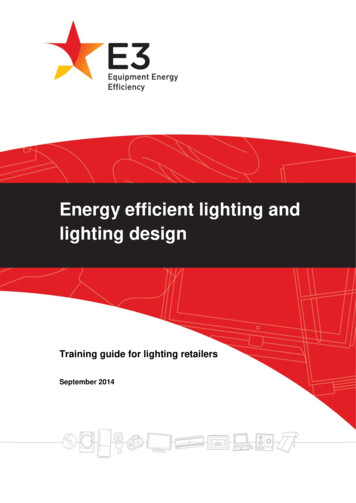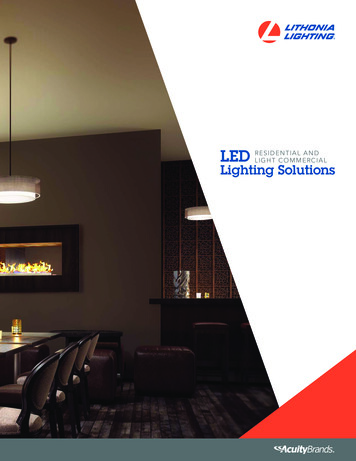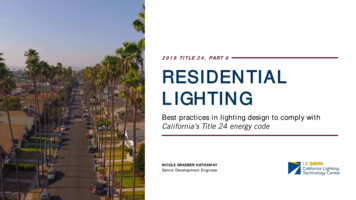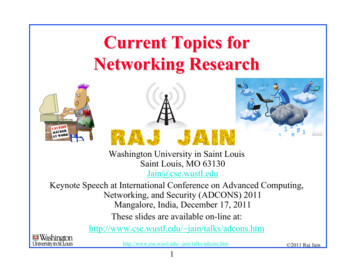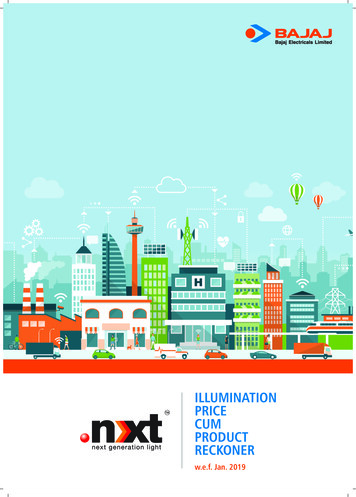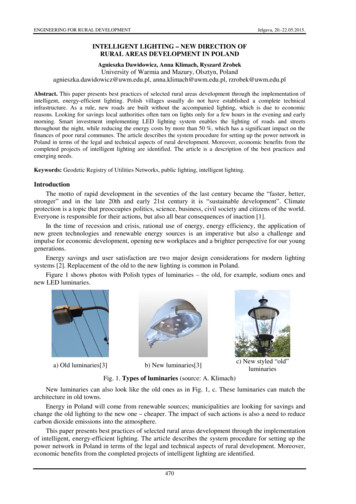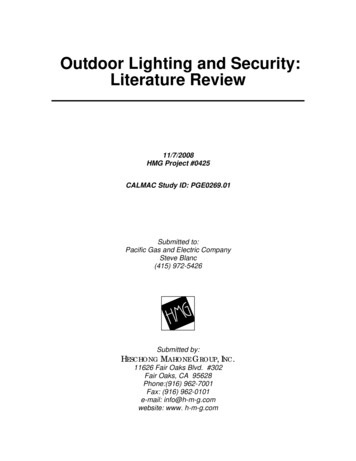
Transcription
Energy Efficient LightingOverviewAccording to the International Energy Agency in 2013 electricity forlighting consumed 20% of the output of the world’s power stations.1 Forthe USA the share of lighting was 15% in 20162. The use of energy efficientlighting is one of the simplest and most cost effective ways of reducingenergy consumption. Efficient lighting programmes can be implementedin several areas within cities by:yy Replacing traditional incandescent bulbs with compact fluorescentlight bulbs (CFLs).Figure 1: CFLs save up to 80% ofenergy compared to incandescentlight bulbsPhoto: Armin Kübelbeck,CC-BY-SA, Wikimedia Commonsyy Replacing old fluorescent tubes with efficient fluorescent tubes.yy Replacing old magnetic ballasts with electronic ballasts in fluorescenttube systems.yy Installing lighting control systems (motion and lux level sensors)yy Using light-emitting diode (LED) technology wherever possible. Thistechnology is developing fast and is getting steadily cheaper. LED’s arenow able to replace most conventional lighting applications, such astraffic lights, down lighters, streetlights, security lights and even striplighting to replace fluorescent tubes.yy Making streetlights more efficient e.g. by replacing mercury vapourlights with high pressure sodium lights or LEDs that operate on arounda third of the power. LED lights have more than double the life span.Decreasing costs makes them financially more viable for street lighting.It is anticipated that LEDswill be used in mostapplications in the future.1 ics/lighting/2 https://www.eia.gov/tools/faqs/faq.cfm?id 99&t 3LED: lights of the futureThe development of LED lights is moving fast. LED alternatives are now availablefor nearly all lighting applications. Their advantages include:yy 80 to 90% more energy efficient compared to incandescent lights; onaverage 20% more efficient than fluorescent lights.yy LEDs have a very long life span of claimed 30000 to 50000 hours.yy LED lights are available in many light colours including the popular warm light of incandescent bulbs.yy LED prices are decreasing fast as this technology becomes more mainstream.It is anticipated that LEDs will be used in most applications in the future.
Municipal InitiativesFigure 2: Types of LED light bulbs.Photo: Geoffrey Landis at English WikipediaImplementationLighting is a significant component of electricity consumption in the residential and commercial sectors that inSouth Africa together consume around 50% of the country’s electricity3. The replacement of lights with highlyenergy efficient ones is one of the simplest and most cost effective measures to reduce electricity consumptionand related greenhouse gas emissions.The replacement of incandescent light bulbs with CFL or LED lights reduces the electricity consumption by around80% to 90%.In a domestic and work environment a task light like thepictured desk lamp is far more energy efficient than generallights at the ceiling because it lights only the area that needsto be lit from a very short distance. If task lights are appliedthe brightness of the general lighting can be strongly reducedresulting in energy savings. A typical desk lamp with CFLbulb needs only 8 to 11W, or with LED bulb only 5W.Figure 3: Desk lamp brightly illuminating asmall areaSource: CC0 Public Domain 12 e/497/South Africa Country Presentation.pdfLighting technologies differ strongly in energy efficiency, life span and price. In order to compare cost all threefactors must be considered. Below are comparisons of energy efficiency, life span and finally lifecycle cost of fourmost common technologies. These are:yy Incandescent,yy Halogen (incandescent technology but bulbs filled with halogen),yy CFL, andyy LED.463 e/497/South Africa Country Presentation.pdf
Energy Efficient LightingThe brightness of light is measured in lumen. The electricity demand of light bulbs is measured in Watt. The lumenrating allows comparing the electricity consumption of different technology light bulbs providing the samebrightness. In the table below lumens and wattage of incandescent, CFL and LED lights are compared. Please notethat the figures are estimates. Especially the LED technology is developing fast becoming more energy efficient(see textbox below).Figure 4: Comparison of brightness (lumens) and power consumption (watt) for different technologiesSource: IDAVIDMCALLEN, /led-watt-conversion-light-replacement-guide/The expected minimum and maximum lifespans of the different technologies are indicated in the figure below. Itis noted that cheap LED lights tend to have a far lower lifespan than more expensive ones.Figure 5: Comparison of lamp life of different technologiesSource: mygreenhome, 014/05/Guide-to-Globes-20-May-v3-.pdf47
Municipal InitiativesLED bulb efficiency and costThe US Energy Information Agency expects the energy efficiency of LED bulbs to increase while prices drop.Figure 6: Average lighting efficacySource: U.S. Energy Information Administration, d 15471#From an electricity system’s perspective energy efficient lighting has the benefit of reducing electricity demand,including during the evening peak period. It therefore contributes to the security of electricity supply in themunicipality and nationwide. Eskom and the DoE have recognized that efficient lighting plays a major role in demandside management (DSM) and have funded programmes for the mass roll-out of CFL lights in the past.From an electricity consumer’s perspective efficient lighting technologies have the following benefits:yy CFL and LED are expected to last several times longer than incandescent bulb and require only one fourth toone fifth of the amount of power. Over their life cycle, these efficiencies more than compensates for the higherpurchasing costs of approximately R25 for CFL and R50 for LED.yy From an environmental perspective, approximately 800kg of CO2 will be saved over the lifetime of one CFL orLED bulb compared to the equivalent incandescent, assuming that the electricity source is a largely coal basedpower station.yy The cheapest way of reducing electricity demand for lighting is behaviour change. It is estimated that throughbehavioural changes. Changes to energy efficient technology should be accompanied with campaign forbehaviour change.yy The replacement of fluorescent tubes (T12 or T8) with more energy efficient ones (T5) and the installation ofelectronic ballast will improve energy efficiency by around 25%.yy Installing sensors in buildings which only switch on lights in the presence of a person (movement sensors) orat insufficient lux levels (light sensors) will further reduce power demand for lighting.48
Energy Efficient LightingWARNINGCFL and fluorescent tubes contain mercury vapour, which makes their safe disposalimportant. They must not be thrown into the general waste but should be taken tospecific recycling facilities or electrical appliance shops for recycling or safe disposal.Some supermarkets also have drop-off containers for CFLs or tubes. The distribution andpromotion of CFLs should be accompanied by education about their safe disposal.This problem does not apply to LED lights.Municipal buildings and facilitiesThe business case for energy efficient lighting is so strong that municipalitiesshould implement energy efficient lighting technologies in their ownbuildings and facilities. This requires them to develop a strategy for thesystematic implementation of energy efficient lighting.In addition, municipalities should promote energy efficient lighting withcommunities and businesses.An energy efficient lighting strategy requires:yy Locating responsibility for retrofits of lighting with a specific department.This is typically the department responsible for maintenance of municipalbuildings.yy Identification and prioritisation of municipal buildings and facilities;drafting a retrofit programme.Lighting BehaviourChanges If a room is wellwindowed, usenatural light andnot electric lighting Turn of lights inunused rooms Use task lightsinstead of ambientlighting whereverpossibleyy Identification of funding for lighting retrofit. This may come from themaintenance budget or through making the case for municipal capitalbudget, arguing that future savings justify higher upfront costs. Additionalfunding can be sourced through the Energy Efficiency Demand SideManagement (EEDSM) programme of the DoE. This programme offersgrant funding for energy efficiency measures.yy To ensure long-term implementation the municipality should adjust itsstandard specifications for lighting so that efficient lighting is routinelyprocured and installed. This may require a capacity building processamongst staff involved in lighting procurement.yy To implementation of any energy efficiency measures including lightingfollows four steps:yy Energy audit of the lighting system and its electricity consumption.yy Design of energy efficiency measures. These can be simple exchanges oflight tubes and bulbs with more efficient ones. However the re-design ofthe whole lighting system may achieve higher savings and rationalisationreducing maintenance costs. This step includes an indication of theexpected savings and estimated pay-back period of the capital cost.49
Municipal Initiativesyy Implementation of the measures. In most cases this will require a tender process and appointment of a serviceprovider (see Green Public Procurement). However, simple replacements of light bulbs and tubes with moreenergy efficient ones can be done in-house e.g. as part of maintenance.yy Monitoring and validation of the energy savings and whether or not they correspond to the design estimates.Figure 7: T5 retrofit adapterIn South Africa the standard tubes are T8, but T12 tubes canstill be found in old buildings. T5 tubes and LED tubes are moreenergy efficient and will likely become the new standard. T12tubes can simply be replaced by T8. For the installation of T5tubes into old fittings a retrofit kit or adapter is required. Forthe fitting of LED tubes the ballast must be by-passed.Source: -with-t8-or-t12-light-fixtures/FINANCIAL ASPECTTo date energy efficient lighting interventions have been implemented by many municipalities in their buildings.The experience shows that the electricity savings typically pay for the new technologies in less than 3 years.Prices of CFLs and particularly of LEDs vary strongly according to the type of light and the quality. In 2017 the pricesof CFL were between R25 and R80 if a single bulb is purchased. Prices for LEDs were in the range of R50 to R120.The University of North West has published a lifecycle costing study for the different technologies for domesticuse taking into account cost of electricity consumption, life span and purchasing costs of lights. The figure belowthat already in 2014 LEDs had the lowest lifecycle costs followed by CFLs.Figure 8: Life Cycle cost comparison of different lighting technologiesSource: NWU, y-saving-home-lighting50
Energy Efficient LightingThe authors of the study state:“In conclusion, the LED has the lowest lifecycle cost making it the most economical, it uses the leastelectrical energy and it does not have any mercury in it making it the most environmentally friendly.Thus, when replacing old light bulbs, spend a little more money on a LED and save more than R1100over the lifecycle of a single LED.” 4In commercial and industrial environments, around 25% electricity savings can be achieved through thereplacement of older fluorescent tubes (T12 or T8) with energy efficient ones (T5)5 and the installation of electronicballast and lighting control systems such as sensors. The costs of T5 tubes are only marginally higher than of T8tubes and retrofit kits are available. Also LED tubes are available that are around 40% more energy efficient thanfluorescent T5 tubes. The prices of LED tubes are decreasing fast but they are currently still around 8 times moreexpensive than fluorescent tubes.Street LightsStreet lights consume around 20% of electricity used for municipal operations6. It is therefore worth focussing onstreet lights to reduce the electricity consumption and costs of the municipality. There are several technologyoptions for street lights that are explained in detail in the brochure “Efficient Public Lighting Guide”. The guide canbe downloaded at http://www.cityenergy.org.za/uploads/resource 17.pdf).The most common ones are listed in the table below and shown in the images on the next page.Table 1: Comparison of different street lighting technologiesTypeOverviewColourof lightLife time(hours)Lumens/WattMercuryVapourPros: inexpensive, medium life spanCons: inefficient, containmercury, get dimmer with agewhite120002400013-48High SodiumPressureHave replaced MercuryVapour in many citiesPros: energy efficient,medium life spanCons: yellow colour, containmercury and Only for small street lightsPros: very energy efficient,good colour renderingCons: limited size; become dimmerwith age, contain mercurySoft white120002000050-80LEDRapidly evolving technology, that isexpected to become mainstreamPros: very energy efficient,long life, low maintenance,Cons: high initial costswhite500007000070-150Source: SEA, 2012: Energy Efficient Lighting Guide (modified)51
Municipal InitiativesFigure 9: Examples of street lighting technologiesSource: SEA. (2012) Sustainable Energy Africa. Energy Efficient Lighting GuideSOLAR STREET LIGHTSFigure 10: Solar street lightPhotographer: Milton DawsonSolar street lights do not need a connection to electrical grid and aretherefore a solution for areas without grid connections. They are standalone units consisting of solar panel, battery, LED light and light sensorthat switches it on and off at dusk and down. Suppliers claim a life spanof five years. The life span of the battery may be shorter. Theft is beingexperienced as a problem of solar street lights.FINANCIAL ASPECTSource: https://commons.wikimedia.org/wiki/File:Mammoth Lakes CA Solar Street Lights.jpgThe replacement of mercury vapour streetlights with high pressuresodium (HPS) streetlights is becoming the norm in cities, due to theenergy and financial savings achievable. LED lights are the technologyof choice due to their long life and related low maintenance costs. Theyare still relatively expensive but are being introduced increasingly due totheir versatility and quality of lighting. They are already cost competitivewith pay-back periods of around seven years when replacing inefficientmercury vapour lights. It is anticipated that the costs of LED street lightswill further come down making them fully cost competitive.The costs of a solar street light depend on its brightness and can beanything between R5000 and R30000. At this cost and considering therisk of theft it is expected that solar street lights will only be used inspecial circumstances in the near future.52
Energy Efficient LightingTraffic LightsTraffic lights are another financially viable field for energy efficiency interventions. The replacement of incandescentor halogen light bulbs with LED ones saves up to 80% of electricity. In addition, LED lights have a much longer lifespan than incandescent and halogen lights. This reduces the maintenance cost of traffic lights.Table 2: Comparison of cost and power consumption of traffic light technologiesCost and energy comparison75WIncandescent55WHalogenLED 8-10WPurchase price for a single traffic signal bulb (R)148400Electricity usage (W)755510Lumens (lm)110015001300Lumens/watt1527130-160Lifespan (hours) for single bulb @ 8hours/day96096014400Bulb cost over 10 years @ 8 hours/day420240800Energy consumption over 10 years for single bulb (KWh)21601584288Energy cost over 10 years @ ave electricity rate ofR0.81/KWh (at est 10% increase p.a) (Rands)1749.61283.04233.28TOTAL Cost over 10 years for single bulb2169.61523.041033.28TOTAL Cost over 10 years for single aspect (3 lights)6508.84569.123099.84Cost saving with LED retrofit of Incandescent traffic signal (single aspect, 3 lamps) over 10 yearsR 3 408.96Energy consumption over 10 years for single bulb21601584288Energy consumption over 10 years for single aspect (3 lights)64804752864Energy saving with LED retrofit of Incandescent traffic signal(single aspect, 3 lamps) over 10 years (KWh)5616 KWhCarbon emissions reduction (t CO2e)5.8 t CO2eMethod notes:Life span of incandescent and halogen bulbs based on 4 months; LED based on 5 years.Average electricity costs estimated as R1.00/kWh.Reduced maintenance costs excluded from calculation.Source: SEA. (2012). Energy Efficient Lighting Guide, updated 2017FINANCIAL ASPECTThere is a very strong case for energy efficient technologies in street lights as LED lights reduce the electricityand maintenance costs strongly. Due to the increased cost of electricity, the payback period of installations madetoday will be significantly less than 3 years.53
Municipal InitiativesFigure 11: eThekwini Municipality,Energy Efficiency StaffCampaign PosterAwareness CampaignsAwareness campaigns should promote energy saving in the workplace andat home includes in lighting. It is important for the success of awarenesscampaigns that messages are sustained, varied and engage the targetgroup. This can be achieved through information on achieved energysavings, requests for feedback, or competitions.Awareness of energy efficiency also needs to be built amongst municipalstaff involved in the procurement and maintenance of lighting equipment.Energy efficiency must determine the procurement policy of lightingequipment.Source: eThekwini Municipality, Energy OfficeThe business case for energy efficient lighting is strong and municipalitiesshould raise awareness with other government institutions, businesses andthe general public of the benefits of energy efficient lighting. This can bedone through environmental education campaigns, and in partnershipwith organised business and education institutions. The municipalitiesshould participate in national programmes should they be implementedagain such as the mass distribution of CFL to households in their areas ofjurisdiction. These programmes should particularly target poor householdsfor whom the higher price of CFL is a barrier to realising the savings ofelectricity costs. Distribution programmes should be repeated to preventhouseholds from reverting to incandescent bulbs once CFL lights arebroken.Municipalities are responsible for waste management and campaignsfor energy efficient lighting must raise awareness of the disposal of CFLsand fluorescent tubes that contain mercury vapour. The safe disposal ofCFLs is an important environmental issue which needs serious attention.Municipalities should cooperate with the electrical appliances and recyclingindustries to develop a safe disposal system that is easily accessible forconsumers in all parts of the municipality.Barriers and opportunitiesThe main barrier to implementing energy efficient lighting is the highinitial costs of installing new lights. Due to the decreasing costs of thenew technologies this barrier is diminishing. In the short term it can beaddressed byyy using grant funding programmes like the EEDSM provided by theDepartment of Energy;yy establishing a policy to implement energy efficient lighting especiallyin buildings where the pay-back periods are typically less than 3 years;Other barriers are limited capacity and knowledge of municipal officialsand companies in this field. With the energy efficient technologies fastbecoming main stream solutions the competence is growing. Trainingcourses should be provided to municipal staff responsible for maintenanceand specialised lighting such as street and traffic lights.54
Energy Efficient LightingAwareness CampaignsAwareness campaigns should promote energy saving in the workplace and at home includes in lighting. It isimportant for the success of awareness campaigns that messages are sustained, varied and engage the target group.This can be achieved through information on achieved energy savings, requests for feedback, or competitions.Awareness of energy efficiency also needs to be built amongst municipal staff involved in the procurementand maintenance of lighting equipment. Energy efficiency must determine the procurement policy of lightingequipment.The business case for energy efficient lighting is strong and municipalities should raise awareness with othergovernment institutions, businesses and the general public of the benefits of energy efficient lighting. This canbe done through environmental education campaigns, and in partnership with organised business and educationinstitutions. The municipalities should participate in national programmes should they be implemented again suchas the mass distribution of CFL to households in their areas of jurisdiction. These programmes should particularlytarget poor households for whom the higher price of CFL is a barrier to realising the savings of electricity costs.Distribution programmes should be repeated to prevent households from reverting to incandescent bulbs onceCFL lights are broken.Municipalities are responsible for waste management and campaigns for energy efficient lighting must raiseawareness of the disposal of CFLs and fluorescent tubes that contain mercury vapour. The safe disposal of CFLs is animportant environmental issue which needs serious attention. Municipalities should cooperate with the electricalappliances and recycling industries to develop a safe disposal system that is easily accessible for consumers in allparts of the municipality.Barriers and opportunitiesThe main barrier to implementing energy efficient lighting is the high initial costs of installing new lights. Due tothe decreasing costs of the new technologies this barrier is diminishing. In the short term it can be addressed byyy using grant funding programmes like the EEDSM provided by the Department of Energy;yy establishing a policy to implement energy efficient lighting especially in buildings where the pay-back periodsare typically less than 3 years;Other barriers are limited capacity and knowledge of municipal officials and companies in this field. With theenergy efficient technologies fast becoming main stream solutions the competence is growing. Training coursesshould be provided to municipal staff responsible for maintenance and specialised lighting such as street andtraffic lights.55
Municipal InitiativesCase study 1: LED Traffic lightsin eThekwini MunicipalityLED traffic lights consist of arrays of tiny light emitting diodes that are extremely energy efficient and have a verylong life. Each LED is about the size of a pencil eraser, and hundreds of them are used together in an array. TheLEDs are replacing the old-style incandescent halogen bulbs rated at between 50 and 75 watts. LED units havethree main advantages: LEDs are more visible because the LED array fills the entire surface of the traffic light making them brighteroverall. LED bulbs last for years, while conventional bulbs in traffic lights only last for months. The longer replacementintervals reduce the maintenance costs considerably. LED bulbs save up to 80% of electricity.Between 2009 and 2011 the eThekwini Municipality has installed LED lights in all traffic lights. 41 000 lights replaced at 759 intersections; Project cost: R41m; 80% saving of electricity achieved amounting to around 6MWh/year; Substantial saving on maintenance costs; Electricity savings along would have resulted in 10 years pay-back period but the additional savings of costshave resulted in 3 to 4 year payback period; and Savings of approximately 6000t CO₂e of greenhouse gas emissions per year.Figure 44: LED traffic lights in DurbanBetween 2009 and 2011 eThekwiniMunicipality installed LEDlights in all its traffic lights.Source: ity ictures/LED traffic lights LR 02.jpg56
Case study: Energy Efficient LightingCase study 2:Efficient Lighting inMunicipal Buildingsin Ekurhuleni MetroThe Ekurhuleni Metropolitan Municipality (EMM) institutionalised asustainable energy approach through energy efficient practices inits municipal buildings already in 2005. The Germiston Civic Centreand EGSC buildings, serving as EMM’s political head office andadministration head office respectively, were identified for energyefficiency retrofits in 2005.Figure 12: various images of the Ekurhulenicase studyEGSC BuildingAmong the energy efficiency measures implemented in bothbuildings, was the replacement of incandescent lights with CFLs,the replacement of cool-beam down lighters with LEDs, and thereplacement of ninety-six, 8-foot double fluorescent light fittingswith 5-foot double fluorescent lights with electronic ballasts. Inaddition lighting timers have been installed. In total 2003 CFLs,90 LED lights and 2 lighting timers were used for the lightingcomponent of the project. The CFLs were found to be highlyefficient. The efficient lighting installations achieved substantialsavings: Pre retrofit energy use: 387 718 kWh/yearGermiston Civic Centre Post retrofit energy use: 109 894 kWh/year Energy savings: 277 823 kWh/year Percentage of energy savings from the use of CFLs and LEDs: 75% Percentage of energy savings from the use of fluorescent lightswith electronic ballasts: 13 %The emissions reduction for greenhouse gases represented in CO2equivalent and other pollutants such as NOx and SOx were:CO2e reduction: 260 tonnes/year8 foot double fluorescent lightsSOx reduction: 2205 Kg/yearNOx reduction: 1 035 Kg/yearThis retrofit project of the lighting component alone has resultedin 387 718 kWh of energy saved in one year. In this year it achievedsaving in the order of R369 000 and a payback period of less thanyear. Additional benefits are the GHG emission reduction of around260 tons of CO2e, 2.2 tons of SOx and 1.1 tons of NOx per year. It isnoted that this project was installed at a time of little experiencewith the new technologies. Apparently, the users were satisfiedwith the equipment and lighting quality.Lights timer set to switch on at 5h30and switch off at 19h00Source: ICLEI. (2005). Improving Energy Efficiency inEkurhuleni Metropolitan Municipal Buildings57
Municipal InitiativesLessons learnedAt the time of this project in Ekurhuleni energy efficiency technology and equipment were new in the SouthAfrican market and it was difficult to find sufficiently experienced tradespeople. This has changed and the CFLand LED are now mainstream products that are produced in the country. Therefore these technologies must bemainstreamed.The formulation of the policy on Energy Efficiency in Council Buildings and on Council Premises, the State ofEnergy Report, the draft Energy Efficiency and Climate Change Strategy of Ekurhuleni and the subsequent retrofitproject have been part of the Ekurhuleni municipal strategy that can be replicated in other South African cities.Case study 3: Efficient Lightingin City Health Building ineThekwini Municipality*Figure 13: eThekwini MunicipalityCity Health BuildingPhoto: S. GodehartThe City Health Building has been selected to pilot an energy efficiencyprogramme for municipal office buildings in eThekwini Municipality. Thepilot is being carried out in collaboration between the Energy Office, theArchitecture Unit and the Health Unit. The purpose is to assess the energyconsumption of a building and select, implement and monitor the mosteffective measures. The project was funded by the EEDSM programme.The assessment was carried out by consultants in 2013. The measures wereimplemented by a contractor in the same year.The City Health Building is a 4-storey office building that accommodates 2labs, an auditorium and large storerooms. The floor area of the building is11,200m². It was built around 1970. Since then the internal uses ofthe building has changed and the additional light fittings have beenadded to the system show in the photograph below.Baseline AssessmentThe baseline assessment showed that lighting constituted 32% of thepower balance in summer and 39% in winter. It was therefore a largecomponent of the overall electricity demand.A specific lighting assessment was conducted. The methodology includedthe compiling of electrical energy balances and noting areas for increasedoptimisation. The assessment included the following elements: Monitoring of power consumption, Inspection and measurement of the lighting installation, Calculation of lighting energy usage, & Calculation of energy savings.The lighting installation comprised almost entirely of fluorescent lampsfitted in a varied range of light fittings. Linear fluorescent lamps madeup 96.5% of the light sources in the building and the bulk of these fittingswere dated and fitted with magnetic ballasts.58* This case study draws extensiviely from: eThekwini Municipality EEDSM 2013-14, Baseline Report: City Health Building. Unlessreferenced otherwise, information is sourced from this document.
Case study: Energy Efficient LightingFigure 14: Winter and summer breakdown of demand for electricity in City Health BuildingSource: eThekwini Municipality EEDSM, 2013-14Minimum lighting levels were generally exceeded but the task lighting was, for the most part, not acceptable.Staff discomfort was experienced. A complete redesign of the lighting is suggested to: comply with the latest applicable standards; make use of new energy efficient light sources;
“In conclusion, the LED has the lowest lifecycle cost making it the most economical, it uses the least electrical energy and it does not have any mercury in it making it the most environmentally friendly. Thus, when replacing old light bulbs, spend a little more money on a LED and save more than R110



